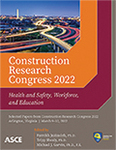A Novel Map-Matching Algorithm for Relating Work Zones and Crashes
Publication: Construction Research Congress 2022
ABSTRACT
Modeling traffic crashes within work zones is critical to crash analysis and prevention, and it requires spatially relating each crash to a specific work zone if applicable. Currently, this is achieved by finding the corresponding work zone recorded for each crash in the crash database, or by assigning a crash to the work zone with the closest reference point to it. The challenges are twofold: (1) crash data can be limited and incomplete. Only a few large work zones are recorded in the crash database; and (2) reference points of a work zone do not accurately represent the work zone area, especially in cases of long work zones along curved roadways. Both issues would cause either inaccurate or infeasible mapping of crashes to work zones, which was overlooked in the work zone related crash analysis in the past. In this paper, a novel map-matching algorithm is developed to accurately and automatically map crashes to their respective work zone projects utilizing their combined attributes, including geographic coordinates, traffic flow directions, and route numbers. The algorithm is tested using the Pennsylvania Crash database and Pennsylvania Roadway Conditions Reporting System (RCRS) data from 2015 to 2017. We show that the new algorithm can substantially reduce the localization error of crashes mapped to work zones from hundreds of meters to meters comparing to existing algorithms. In addition, the proposed algorithm is computationally efficient, which takes tens of hours for mapping all crashes in the state-level roadway networks on a regular personal computer.
Get full access to this article
View all available purchase options and get full access to this chapter.
REFERENCES
AASHTO. (2010). Highway safety manual.
ARTBA. (2021). “National Estimates of Total and Injury Work Zone Crashes.” The National Work Zone Safety Information Clearinghouse, <https://www.workzonesafety.org/crash-information/work-zone-injuries-injury-property-damage-crashes/>(Feb. 22, 2021).
Call, D. A., Wilson, C. S., and Shourd, K. N. (2018). “Hazardous weather conditions and multiple-vehicle chain-reaction crashes in the United States.” Meteorological Applications, 25(3), 466–471.
Chen, E., and Tarko, A. P. (2014). “Modeling safety of highway work zones with random parameters and random effects models.” Analytic Methods in Accident Research, 1, 86–95.
Cheng, Y., Parker, S. T., Ran, B., and Noyce, D. A. (2012). “Enhanced Analysis of Work Zone Safety through Integration of Statewide Crash and Lane Closure System Data.” Transportation Research Record, 2291(1), 17–25.
Cheng, Y., Parker, S. T., Ran, B., and Noyce, D. A. (2016). “Work Zone Crash Cost Prediction with a Least Median Squares Linear Regression Model.” Transportation Research Record, 2555(1), 38–45.
Edara, P., Sun, C., Brown, H., Rahmani, R., and Datta, T. (2016). “Development and Application of Work Zone Crash Modification Factors.”
FHWA. (2019). “Work Zone Facts and Statistics.” <https://ops.fhwa.dot.gov/wz/resources/facts_stats.htm#ftn2>(Oct. 22, 2019).
FHWA. (2021). Work Zone Data Exchange (WZDx) Specification. US DOT ITS JPO ODE.
Gross, F., Persaud, B. N., and Lyon, C. (2010). A guide to developing quality crash modification factors. United States. Federal Highway Administration. Office of Safety.
Ha, T.-J., and Nemeth, Z. A. (1995). “DETAILED STUDY OF ACCIDENT EXPERIENCE IN CONSTRUCTION AND MAINTENANCE ZONES.” Transportation Research Record, (1509).
Hu, G., Shao, J., Liu, F., Wang, Y., and Shen, H. T. (2017). “IF-Matching: Towards Accurate Map-Matching with Information Fusion.” IEEE Transactions on Knowledge and Data Engineering, 29(1), 114–127.
Imprialou, M., and Quddus, M. (2019). “Crash data quality for road safety research: Current state and future directions.” Accident Analysis & Prevention, Road Safety Data Considerations, 130, 84–90.
Imprialou, M.-I. M., Quddus, M., and Pitfield, D. E. (2015). “Multilevel Logistic Regression Modeling for Crash Mapping in Metropolitan Areas.” Transportation Research Record, 2514(1), 39–47.
Jensen, C. S., and Tradišauskas, N. (2009). “Map Matching.” Encyclopedia of Database Systems, L. LIU and M. T. ÖZSU, eds., Springer US, Boston, MA, 1692–1696.
Jin, T. G., Saito, M., and Eggett, D. L. (2008). “Statistical comparisons of the crash characteristics on highways between construction time and non-construction time.” Accident Analysis & Prevention, 40(6), 2015–2023.
Khattak, A. J., Khattak, A. J., and Council, F. M. (2002). “Effects of work zone presence on injury and non-injury crashes.” Accident Analysis & Prevention, 34(1), 19–29.
Lou, Y., Zhang, C., Zheng, Y., Xie, X., Wang, W., and Huang, Y. (2009). “Map-matching for low-sampling-rate GPS trajectories.” Proceedings of the 17th ACM SIGSPATIAL International Conference on Advances in Geographic Information Systems, GIS ’09, Association for Computing Machinery, Seattle, Washington, 352–361.
Ozturk, O., Ozbay, K., and Yang, H. (2014). “Estimating the Impact of Work Zones on Highway Safety.”
Pigman, J. G., and Agent, K. R. (1990). “Highway Accidents in Construction and Maintenance Work Zones.” Transportation Research Record: Journal of the Transportation Research Board, 1270, 12–21.
Ullman, G. L., and Scriba, T. A. (2004). “Revisiting the Influence of Crash Report Forms on Work Zone Crash Data.” Transportation Research Record.
Wang, J., Hughes, W. E., Council, F. M., and Paniati, J. F. (1996). “Investigation of Highway Work Zone Crashes: What We Know and What We Don’t Know.” Transportation Research Record, 1529(1), 54–62.
Xing, F., Huang, H., Zhan, Z., Zhai, X., Ou, C., Sze, N. N., and Hon, K. K. (2019). “Hourly associations between weather factors and traffic crashes: Non-linear and lag effects.” Analytic Methods in Accident Research, 24, 100109.
Information & Authors
Information
Published In
History
Published online: Mar 7, 2022
Authors
Metrics & Citations
Metrics
Citations
Download citation
If you have the appropriate software installed, you can download article citation data to the citation manager of your choice. Simply select your manager software from the list below and click Download.
